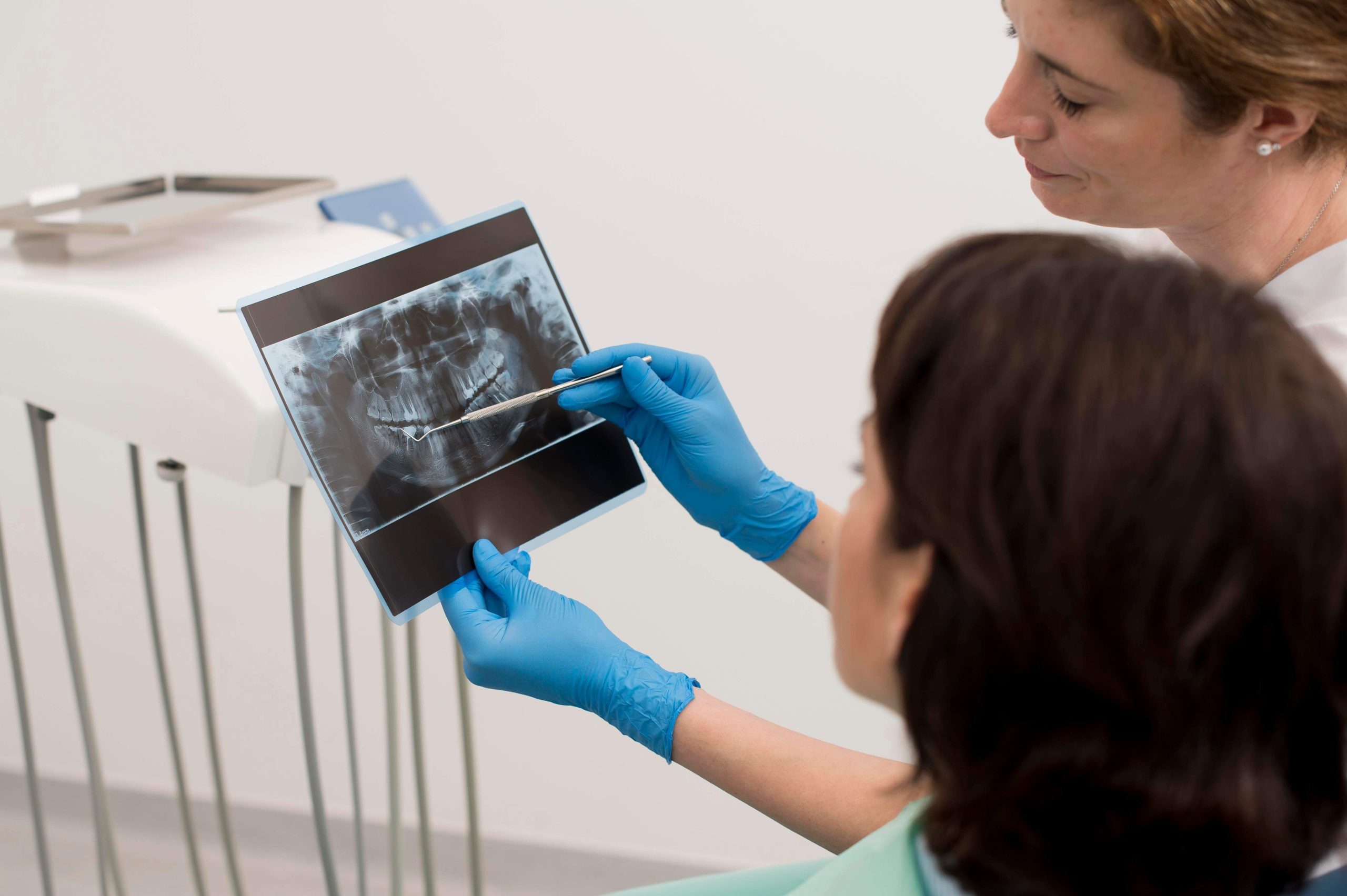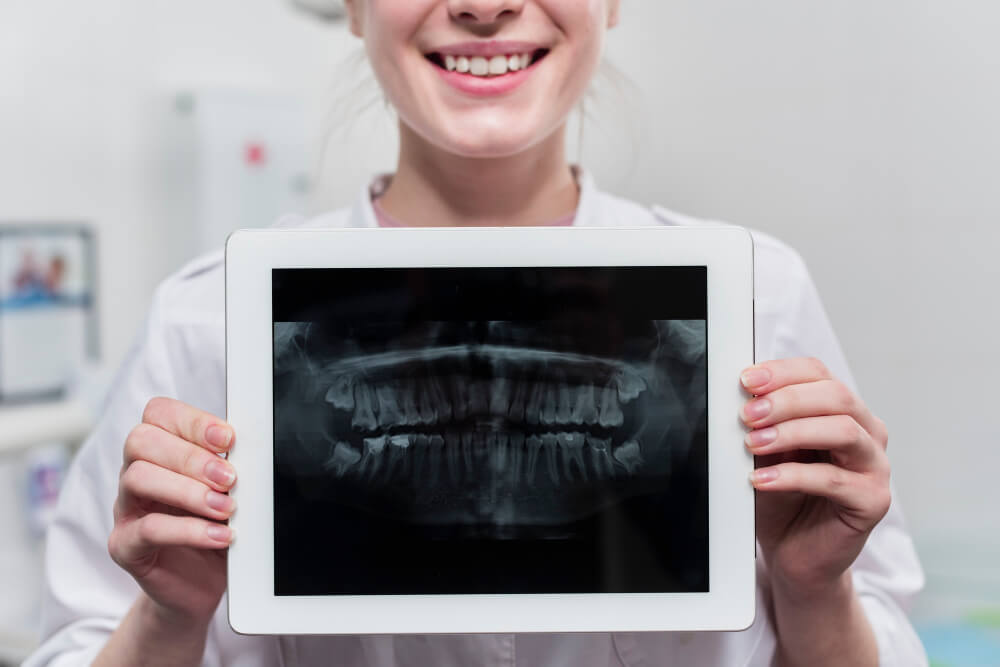Campbelltown Dental X-Rays: The Key to Catching Oral Problems Before They Start

One of the primary reasons patients visit us at A Plus Dental is to identify dental problems before they become severe and costly concerns.
While physical examinations can detect apparent issues, some oral problems just aren’t visible to the unaided eye. This is why dental X-rays are such a critical tool in dental care.
Dental X-rays can uncover even the slightest traces of oral health problems at their earliest stages, such as cavities, gum disease, oral infections, and some types of tumours.
Thanks to dental X-rays, we can diagnose and treat dental problems long before they become more serious. With the early detection that X-rays allow, you can get the treatment you need before problems have a chance to develop.
Why dental X-rays are performed
If you’re a new patient, you’ll likely receive dental X-rays to give your dentist a clear picture of your dental health.
Children may need dental X-rays more frequently than adults because their teeth and jaws are changing at a much faster rate than those of adults.
What issues can dental X-rays detect?
For adults, dental X-rays are used to:
- Reveal areas of decay that may not be visible to the dentist’s eye
- Identify bone loss resulting from gum disease and reveal decay occurring under an existing dental filling
- Uncover dental abscesses
- Find changes in the bone or root canals caused by infection
- Reveal other developmental abnormalities, such as cysts and some tumours
In children, dental X-rays are used to:
- Reveal decay
- Discover if there is enough space in the mouth and jaw to accommodate incoming teeth
- Reveal if primary teeth are coming out quickly enough to allow permanent teeth to come in properly
- Estimate the development of wisdom teeth and determine if they are impacted
Types of X-rays
Bitewing, periapical, and panoramic radiographs are the X-rays most commonly used in dental offices. During routine exams, a dentist may take two to four bitewing x-rays – which show the crown portions of your teeth – to spot early signs of decay between your teeth.
Periapical X-rays provide the best view of your teeth’s bone height or root tips. A panoramic X-ray is taken from outside the mouth, providing a single, large image of the entire oral cavity. Because the image shows all of the teeth, the upper and lower jaws, and the sinus areas, this type of X-ray can identify cysts, impaction, tumours, bone irregularities, and jaw disorders.
Other radiographs include occlusal X-rays, which are sometimes taken in children to evaluate the development of their teeth and cephalometric X-rays, used to assist in planning orthodontic treatment.

How often should dental X-rays be performed?
Dental X-rays are typically performed once a year. They can be given more often if your Campbelltown dentist is monitoring the progress of a dental issue or treatment.
Factors affecting how often you receive dental X-rays may include:
- how old you are
- your existing oral health
- any symptoms of oral disease
- a history of gum disease (gingivitis) or tooth decay
The frequency of X-rays on your teeth is related to your medical history, dental history, and overall condition. Some people may require X-rays twice a year, while others with no recent oral issues and who visit their dentist on schedule may get X-rays only every couple of years.
For most new patients, dentists take X-rays as part of a comprehensive initial examination to establish a baseline from which to compare changes that occur over time.
High risk of dental problems is another criteria:
- Patients with extensive dental work.
- People who drink too many sugary beverages (as a sugar-filled mouth creates a perfect environment for cavities to develop).
- People with periodontal (gum) disease to monitor bone loss.
- People who suffer from dry mouth—or xerostomia — whether due to medicines (such as antidepressants, anti-anxiety drugs, antihistamines, and others) or other issues (such as damaged salivary glands, Sjögren’s syndrome, or radiation treatment to head and neck). Dry mouth can lead to the quick development of cavities.
- Smokers to keep track of bone loss resulting from periodontal disease (smokers are at increased risk of periodontal disease)
Pregnancy and dental X-rays
If you’re pregnant, you may wonder whether it’s safe to have dental X-rays. The good news is that dental X-rays involve very low radiation exposure, limited to the area around your teeth and mouth.
With appropriate shielding, they’re generally considered safe, even during pregnancy. As always, let your Campbelltown dentist know if you’re expecting so we can tailor your care accordingly.
Dental X-rays in Campbelltown
Your Campbelltown dentist sees dental X-rays as an essential part of preventive care. They enable us to detect concerns like decay, bone loss, and infections early—often before you experience any symptoms.
With clear diagnostic insight, we can recommend the most suitable treatment plan and help you avoid more complex dental issues in the future.
Whether you’re due for your routine check-up or managing a specific dental concern, we’ll take the time to guide you through every step. Our team is committed to making your visit as comfortable and informative as possible.
Call (02) 4627 3833 or visit us at Suite 3/300 Queen Street in Campbelltown


